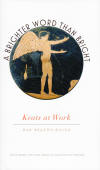A Brighter Word Than Bright
“Biographies are but the clothes and buttons of the man. The biography of the man himself cannot be written.” Mark Twain’s observation about biography reminds us that life-writing is nothing if not a tricky genre—where the clothes and buttons of a person’s life are cut, tailored, and assembled into a specific narrative. How a biographer weaves together the threads of the clothes heavily influences how an audience internalizes a person and his/her life.
“Biographies are but the clothes and buttons of the man. The biography of the man himself cannot be written.” Mark Twain’s observation about biography reminds us that life-writing is nothing if not a tricky genre—where the clothes and buttons of a person’s life are cut, tailored, and assembled into a specific narrative. How a biographer weaves together the threads of the clothes heavily influences how an audience internalizes a person and his/her life.
However, not all biography needs to follow a, shall we say, “womb to tomb” narrative, and good biography can include writing outside of a strict interpretation of the genre. Good biography also includes critical reflection about the proper context of the subject’s life, whether that context is presented linearly through a life’s chronology or thematically through the poet’s own writings. (For example, in a brilliant twist of biographic sourcing, Herbert Leibowitz lets the American poet William Carlos Williams tell his own life story, through Williams’s poetry, letters, essays, and critiques, in Something Urgent I Have to Say to You.)
The canon and compilations of John Keats’s poetry is, in a word, vast; library shelves fairly bend under the collections’ weight. To many, Keats is “that urn guy” they read in high school. To others, he is a talented poet and a tragic figure whose odes and sonnets only received critical acclaim after his death. To Dan Beachy-Quick, in A Brighter Word Than Bright, Keats is a creative work-in-progress. This treatment of Keats’s life and poetry is complex and thoughtfully provocative, and sits somewhere between traditional biography and analytical critique, making A Brighter Word Than Bright a poetry biography of sorts.
Beachy-Quick writes: “Sometimes I think a poetic presses down upon the poet’s mind as does a seal upon the soft wax that closes a letter.” A Brighter Word Than Bright focuses on Keats’s active writing years and the poetic trends within them. Through seven chronological portrait sketches spanning 1816-1820, Beachy-Quick illustrates the impetuses, the motivations, and the provocations of Keats’s work. Beachy-Quick is particularly successful through his short, reflective commentaries, neatly framed through vignettes from the poet’s life. In order to unpack the lyric complexities of, say, Endymion, the audience is given the context for “things of beauty” and why Keats would consider these things to be joys forever. To that end, letters from Keats’s correspondence (“There is no greater Sin after the 7 deadly than to flatter oneself into an idea of being a great Poet”) provide a temporal bounding. We see Keats take the challenge of fellow poet Leigh Hunt to write such a lengthy piece, and through the letters and analysis, we understand the inspirations and backdrop to the poem. We see how the poem, itself, came to Be in that aesthetic realm of Being.
Keats understands poetry not as presentation but as “a work creative of essence”—there’s an almost life cycle to poetry, itself, then. This life cycle of birth, life, death, and afterlife (or perhaps resurrection) juxtaposes the human condition with Romantic aesthetics. A poem—indeed, a poet—is never dead and the heaviness of that realization (that responsibility?) weighs on Keats in his writings. Indeed, in the re-imaging of ancient Greek literature, art, and philosophy Keats shows his audiences more of himself than might be expected, best illustrated in the portrait “Psyche; or, The Wreath’d Trellis of a Working Brain.”
Keats’s original “Ode to Psyche” (as reprinted in A Brighter Word Than Bright):
O Goddess! hear these tuneless numbers, wrung
By sweet enforcement and remembrance dear,
And pardon that they secrets should be sung
Even into thine own soft-conched ear.
Beachy-Quick reads this stanza as:
[Keats] has come to a sense of the poem—and more largely, of poetry—as entwined with fundamental ironies. Inescapable inversion seem a primary consequence of poetry as a phenomenal practice. Poetry, Keats has leaned, can keep no secrets; it shows the secret forth. . . . But a poem keeps no words silent.
Each of the seven Keatsian portraits connects readers to the mimetic realism and Romantic representations of four years of Keats’s writing. While certainly scholarly—through deep, careful, and thoughtful analysis—A Brighter Word Than Bright is more than only a measured critique of poems. The book shines as a means of writing good biography in unexpected ways. Notes, themes, and archival sources are the fabric of Twainian “clothes and buttons” in Beachy-Quick’s treatment of Keats, letting Keats tell his own life story, as it were. A Brighter Word Than Bright is a beautiful, meditative reading (and telling) of Keats and his life.





